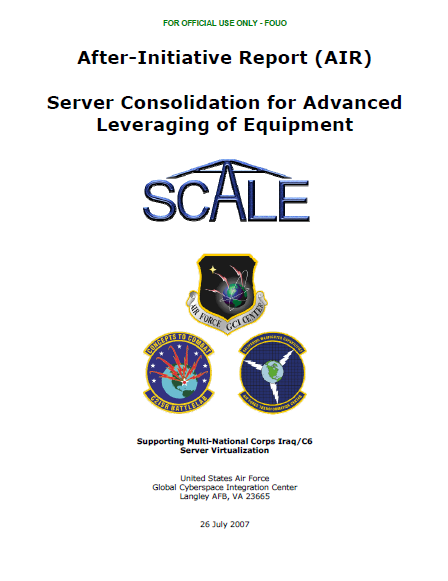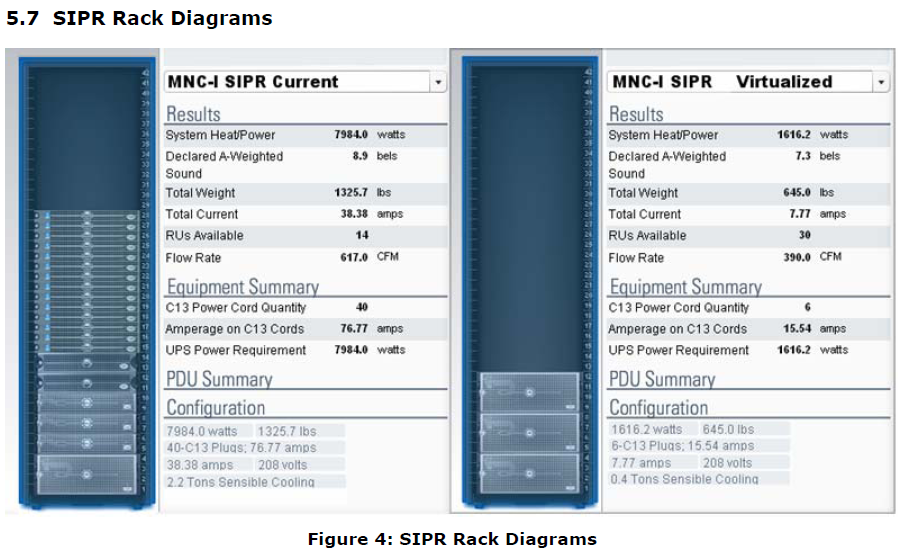 Supporting Multi-National Corps Iraq/C6 Server Virtualization
Supporting Multi-National Corps Iraq/C6 Server Virtualization
- Global Cyberspace Integration Center
- 35 pages
- For Official Use Only
- July 26, 2007
EXECUTIVE SUMMARY
Mission Statement. Server Consolidation for Advanced Leveraging of Equipment (SCALE) evaluates VMware ESX Server 3.0.1 virtualization software for use at Camp Victory, Baghdad, Iraq. Global Cyberspace Integration Center (GCIC) personnel and Multi-National Corps – Iraq, C6 (MNC-I/C6) synchronized efforts to reduce information technology (IT) equipment, power, space, and heating, ventilation, & air conditioning (HVAC) demands while increasing system redundancy and scalability for Non-Secure Internet Protocol Router Network (NIPRNet), Secure Internet Protocol Router Network (SIPRNet), and Combined Enterprise Regional Information Exchange System (CENTRIXS) in direct support to 8,000 Coalition warfighters.
Course of Action. The GCIC/MIO (formerly the Command and Control Intelligence, Surveillance, Reconnaissance Battlelab (C2ISRB)) evaluated the server virtualization technology in three phases. In Phase I the team virtualized the common server environment reducing the environment from nine servers to two. In Phase II the team transferred the legacy system to the new virtualized hardware and matched the MNC-I/C6 configuration. In Phase III the team evaluated the impact of a physical failure on the virtual environment.
Results. VMware shrinks the server count 84% from 56 to nine with power savings of 78%. This provides an estimated $16K a year in electrical cost avoidance alone. VMware-based solution also weighs 48% less, reclaims 57% rack space, and saves 80% on current HVAC demands.
Recommendations. Server virtualization significantly impacts system administration by reducing resource allocation and increasing capabilities. Virtualization reduces the costs of the Air Operations Center (AOC) server environment with a smaller, more efficient solution. Recommended that virtualization be implemented in existing server systems throughout the Air Force and Department of Defense (DoD).…
1.1 Purpose
SCALE seeks to reduce power, space, and HVAC demands while increasing system redundancy and scalability for NIPRNet, SIPRNet, and CENTRIXS by evaluating server virtualization using VMware. SCALE focuses specifically on feedback concerning automatic fail-over while increasing system survivability.
1.2 Background
SCALE was initiated in response to server area challenges faced by the MNC-I/C6. MNC-I is a tactical unit responsible for command and control operations throughout Iraq divided into six areas of responsibility (AORs) maintained by forces from 26 countries. The C6 unit in Baghdad provides network resources to over 8,000 Coalition personnel. In January 2007, personnel from MNC-I/C6 approached the GCIC (formerly C2ISRB) for assistance evaluating server virtualization technology.
Over time, MNC-I/C6’s server infrastructure grew to consist of numerous servers thereby creating a severe deficiency of physical space (including lack of test bed and lack of spare manpower or network capacity to evaluate virtualization). Given the location’s hash environment, the cooling requirement for that location was at a breaking point. The MNC-I/C6 also faced an upcoming Baghdad troop surge that would further tax the situation.
Limited resources existed for MNC-I/C6 personnel to standup and maintain a test bed environment to evaluate server virtualization. In addition, MNC-I/C6 needed to expand redundancy of critical components and viewed server virtualization as a possible solution.
1.3 Virtualization Overview
Virtualization consolidates many physical servers into fewer servers. Each physical server is reflected as a virtual machine residing on a virtual machine host system. This is also known as a physical-to-virtual (P2V) transformation. Typically, a server supports a single application using only a small fraction of processing power. When a new application is brought online, a new server is added taxing electrical, cooling, and real estate resources.
Server virtualization utilizes unused processor cycles to power virtual machines. Virtualization also lowers power consumption, heat generated, and a smaller overall footprint needed for server infrastructure. These recapitalized resources provide a more robust environment, easier disaster recovery, and increased flexibility not possible in a tradition environment.
1.4 Benefits of Virtualization
Virtualization provides the following benefits:
- Taps into lost processing capabilities by turning a single function server into a multi-functional server
- Harnesses unused server processing power with no performance degradation
- Conserves valuable resources by decreasing space, power, and HVAC requirements
- Increases redundancy, i.e., increased survivability through redundancy
1.5 Length of Time
The SCALE-I evaluation initiative commenced in January 2007 and completed in June 2007.
…



